
Concealed from the human eyes for thousands of years, the Ajanta Caves, situated at a distance of 107 km north of Aurangabad in India, were accidentally discovered on a certain day in 1819, by an Army Officer in the Madras Regiment of the British Army. The said Army man, named John Smith, was in fact separated from his friends during one of his hunting expeditions, after they were attacked by a tiger on that day. Instinctively, John Smith fled into the deep mountain jungle to save his life and consequently lost his way. While he was trying to find out his way, suddenly from a long distance, his eyes caught sight of a curious shaped rock-wall covered with bushes and shrubs.
Instinctively, he became curious and his inquisitiveness drew him nearer the rock-wall. As he approached, he was surprised to find a horseshoe shaped window, excavated in the rock with minute carvings. He was amazed and reported his experience to his superiors, when he could find his way and managed to come back to his camp. Fortunately, the higher authorities did not make the mistake to overlook the matter. They took it seriously, started to excavate to spot without delay and the result of their effort shook the world. They discovered a chain of rock-cut ancient caves with hundreds of paintings, which include among others, figures of Lord Buddha and the stories of his past lives and rebirths, pictorial tales from Aryasura's ‘Jatakamala’, as well as rock-cut sculptures of Buddhist deities painted on verandas, inner walls and ceilings. Apart from that, there are also some figures, depicted in Hindu mythology and commonly known as the ‘Yakshas’, the 'Kinnaras' (half human and half bird), the 'Gandharvas' (divine musicians) and the 'Apsaras' (heavenly dancers).

The Ajanta Caves were estimated to have been hewn from solid rock periodically, the first belonging to the 2nd century BC to 1st century AD, and second period that followed several centuries later. It was also considered that, the caves, famous for its murals, are the finest surviving examples of the ancient Indian art and they are some of the most beautiful masterpieces of world art.
The Ajanta Caves, lying deep within the Sahyadri Hills, were hewn out of the rock in a horse-shoe shaped cliff, where River Wagura is flowing at the bottom. The river falls from a height of 200 feet, consequently making a series of waterfalls. The location of the area, far away from the madding crowd, provided a calm, peaceful and serene environment for the Buddhist monks who used to retreat at these secluded places during the rainy seasons. During their stay, they adorned the caves with their outstanding architectural skills and artistic paintings. In those early days, the caves were methodically connected to the stream by a flight of steps, which are now almost lost.
Among the excavated caves, five caves (nos. 9 /10 /19 /26 and 29) are Chaitya Grihas or Stupa Halls and the rest are Viharas or dwelling halls.


The earliest group of Ajanta consists of caves 9 /10 /12 /13 and 15A. It is generally accepted that, this group belong to the Hinayana tradition of Buddhism. But, there is difference of opinion regarding the century of initiation of the caves. It is said that, they were made during the period 100 BC to 100 AD, probably under the patronage of the Hindu Satavahana Dynasty. However, others opined that, they were built during the Maurya Empire (300 BC to 100 AD). In the earliest group, cave 9 and 10 are Stupas, which contain worship halls or Chaitya Griha, and caves 12, 13, and 15A are Viharas. However, the earliest group of the Satavahana period lacked figurative sculpture, emphasizing the stupa instead.
After the completion of the earliest group of caves, further development was postponed for a considerable period of time, which extended until the mid-5th century. However, during the dormant period, those caves were in use and visited by the Buddhist pilgrims, as recorded by the Chinese pilgrim Fa Hien in his account around 400 BC.
The second phase of construction at the Ajanta Caves, which began in the 5th century, is attributed to the theistic Mahayana tradition of Buddhism. According to the recent studies, construction of this phase probably spanned over a very brief period, from 460 to 480 AD. This phase consists of cave nos. 1–8, 11 and 14–29, which included some refurbishing and repainting of the early caves. It is generally maintained that, the construction and decoration of the second phase corresponds to the very zenith India’s golden age.


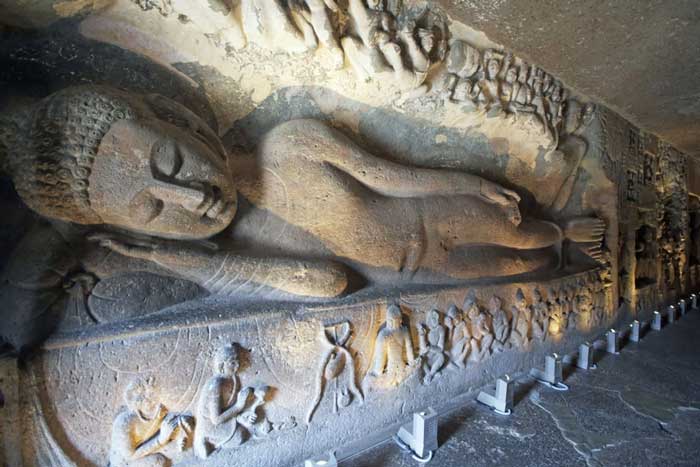
The caves of Ajanta are carved out of flood basalt rock, formed by successive volcanic eruptions billions of years ago. Since the rock is layered horizontally, the artists had to amend their carving methods. The sculpture artists had to work at both excavating the rocks and making the intricate carvings of pillars, roof and idols. Moreover, the sculpture and painting work inside a cave were integrated parallel tasks. At the apex of the gorge's horseshoe, between caves 15 and 16, a grand gateway to the site was created, which is decorated with elephants on both side and a protective Naga (snake) deity.
The majority of the caves are Vihara or dwelling halls with symmetrical square plans. Each Vihara is attached to smaller square dormitory cells, cut into the walls. The central square space of the interior of the Viharas is defined by square columns forming a more or less square open area. Along the side and rear walls are a number of small monks’ cells with a narrow doorway, originally equipped with wooden doors. The centre of the rear wall has a larger shrine-room behind, containing a large Buddha statue.
The Chaitya Grihas or Stupa Halls, the other type of main hall architecture in Ajanta, has narrower rectangular plan with high arched ceiling. The hall is longitudinally divided into a nave and two narrower side aisles, separated by a symmetrical row of pillars, with a stupa in the apse, which is a semicircular recess, covered with a hemispherical vault or a semi-dom. The stupa is surrounded by pillars and a concentric walking space, circumambulate, known in Sanskrit as pradakśina or pradakshinaṇā. Some of the caves have elaborate carved entrances, some with large windows over the door to admit light
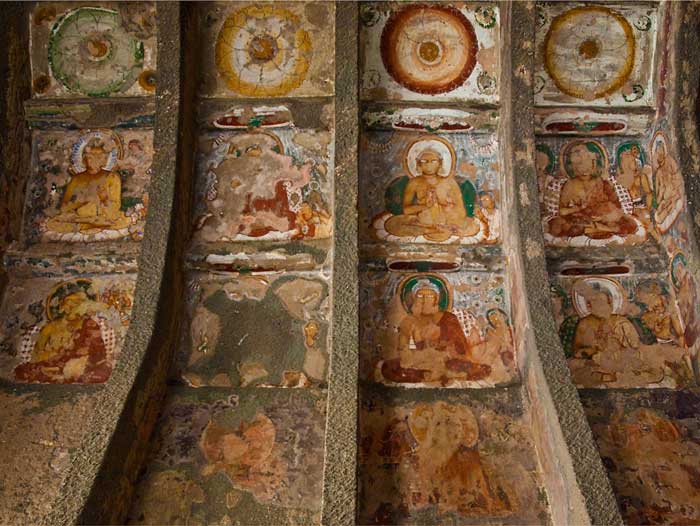
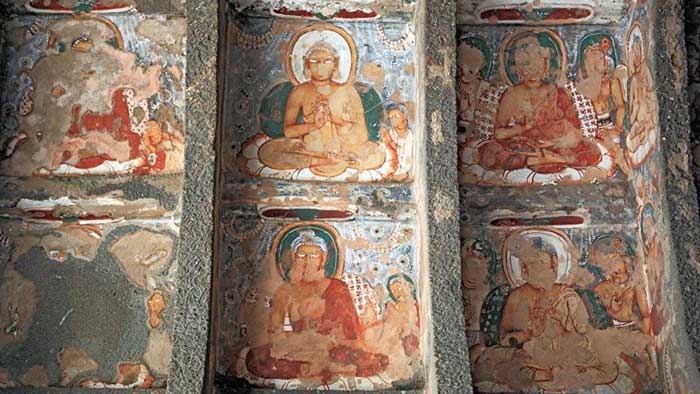
Murals in Ajanta were made in a specific indigenous way, involving several stages of work. At first, the stone surface was chiseled to make it rough, so that it can hold the plaster. Then a rough plaster of clay, cow dung, and rice husks were pressed on to the rough cave walls. This was then coated with lime juice in order to create a smooth working surface. Finally, the paintings were made in tempera, on the top of a wet plaster surface rather than on the dry plaster, to ensuring long life of colours. Plastering was done by really skillful artisans. Some of sculptures were even plastered to get the effect of smoothness. Unusual shine was achieved by adding powdered conches and seashells. Natural resources like red and yellow soil (ocher), crushed green malachite, blue lapis lazuli, lime, kaolin, gypsum, lamp black etc. were used by the artists for the pigmentation of their pictures. Perhaps due to the adoption of this aboriginal technique, the paintings could preserve some of their original glory even after 1,500 years of abandonment in tropical climate

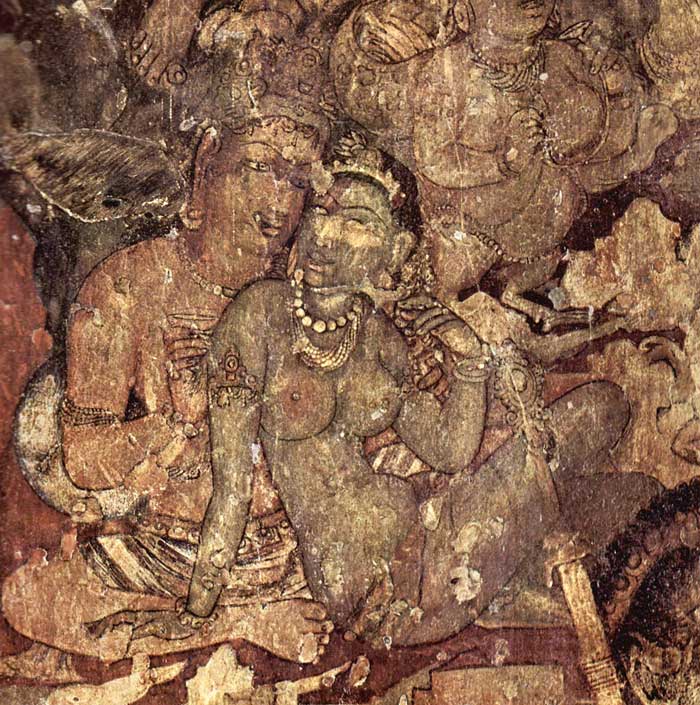
Four of the later caves of Ajanta have large and relatively well-preserved mural paintings which, represent the great glories not only of Gupta but of all Indian art.The paintings in the Ajanta caves have close resemblance with the classical Greek art, which is not unlikely, as the Greco-Indian culture had spread from the 4th Century BC expeditions of Alexander the Great. The Ajanta murals are classical, luxurious, sensuous and celebrate physical beauty, which in the eyes of the western observers are shocking and out of place in these caves presumed to be meant for religious worship and ascetic monastic life.

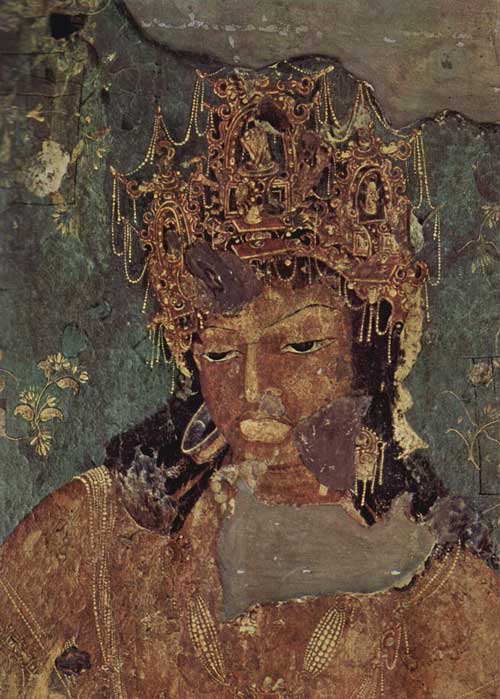

The aesthetic and mesmerizing paintings and sculptures of Ajanta are considered as marvels of classical Indian art and a part of world heritage. However, time takes its toll. The paintings have deteriorated significantly since they were rediscovered. Though some paintings have miraculously survived, many have lost their past beauty. Forgotten for more than 1,000 years of silence and hidden by the prodigious foliage in the realm of the wild and the wilderness, this magnificent work of art, architecture and contemplation, was abandoned by those who created it as long ago as AD 500. Fortunately, today the site is a protected monument in the care of the Archaeological Survey of India and since 1983, the Ajanta Caves have become a UNESCO World Heritage Site.